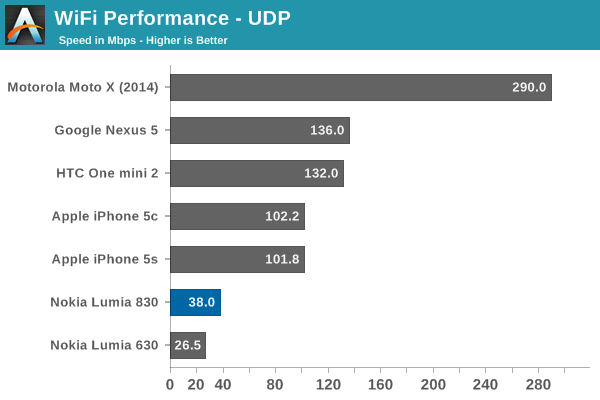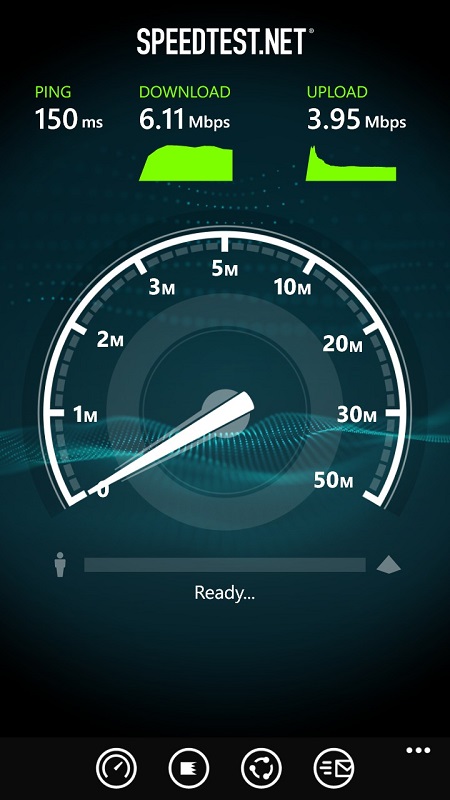Nokia Lumia 830 Review
by Brett Howse on November 25, 2014 8:00 AM EST- Posted in
- Smartphones
- Microsoft
- Lumia
Wi-Fi
The Lumia 830 most likely unitizes the Qualcomm VIVE Wi-Fi available on the Snapdragon 400 SoC. In this particular case, it is nothing special. The 830 has a single stream only, although at least it is dual band. This gives us a maximum connection speed of 150 Mbps, which the Lumia 830 was able to achieve. However connection speeds rarely equate to real world transfer speeds.

I was only able to achieve 38 Mbps transfer speed with the Lumia 830, which is not a stellar result. On a device of this price range, it would be nice to see 802.11ac wireless and possibly a dual-stream solution.
There is one other note about Wi-Fi. On one occasion, the device stopped seeing any access points at all. I had to restart the phone, at which point the Wi-Fi worked normally again. I’ve contacted Microsoft and this is a known issue on some Lumia 830 devices. They have no fix for this yet, so if you do purchase one and have this happen, you may want to exchange it. It happened just the one time to me though.
Cellular
Qualcomm’s MSM8926 SoC supports up to Category 4 LTE which offers a maximum of 150 Mbps download and 50 Mbps Upload.
I was only able to achieve 6 Mbps download and 4 Mbps upload but these numbers have a lot to do with the traffic on the tower, as well as location and obstacles.
Reception is good but this is difficult to test unless you live on the fringe of a cellular signal and I do not.
GNSS
Qualcomm’s IZat Gen8A is the GPS in the Snapdragon 400 SoC, and as with most modern Qualcomm location solutions it is fast and accurate. With location services enabled on the phone, GPS lock happened within a couple of seconds. Going from location services disabled to a GPS lock took around thirty seconds, which is pretty good.
The Lumia 830 supports A-GLONASS, A-GPS, BeiDou, and assist from cellular and Wi-Fi networks to get a quicker location fix.
Speaker and Call Quality
The Lumia 830 has a single speaker on the back of the device, which is never the ideal location for maximum clarity and volume. The tiny speaker does get plenty loud though. I measured 88.7 dBA from the speaker from 3” away.
The Lumia 830 has four microphones for noise cancelling. Below is the audio of a call from the 830 to my personal cell, which I recorded on my PC. There is a bit of whine in the recording from my PC so please ignore that I will try and get that sorted out for the next review.
The 830 does a good job cancelling out the outside noise during a call, with it only struggling when the ambient noise was high enough that it would be difficult to speak face to face. The audio quality of the call was also quite good.












98 Comments
View All Comments
cheshirster - Friday, November 28, 2014 - link
Moto G can barely fight with 630. Definetly not with 735 and 830.CaedenV - Tuesday, November 25, 2014 - link
like others here I have a 2 year old Lumia 920 and am looking for an upgrade, but there are limited options available. When I was essentially running a business out of my cell phone I was looking to upgrade to the 1520 (or better yet the long rumored 1525 what seems to have gone up in smoke), but now that I am a student and have a laptop a normal sized phone sounds much more appealing.I was looking really hard at the Icon/930, but the lack of Glance and SD card support are in fact deal-breakers. I use glance all of the time on my 920 (especially now that weather shows up on Glance... best simple feature ever!), and if I had SD support then I could fit my whole music collection, as well as more pics and vids of the kiddos to show off to friends and family. Plus the fact that it is only available on VZW, and I am not going there and will stick with ATT/T-Mo for service.
So then that leaves the 830. Playing with it in person, it is a great little device, and if you sell off the useless bundled fitbit for ~$80+ then the price is more than reasonable. It is a step down from the Lumia 920... but only a minor step down, and some things (like SD support, much lighter weight and slimmer design, significantly better camera, bigger display/less bezel, etc.).
But at the end of the day it is not a flagship. The processor is slower than the 920 for most of my uses (may be different if you play more games), the screen quality/resolution is lower, the build quality is not as good... it is exactly as advertised: an "affordable flagship" with all of the features, but at lower spec. The other issue is that it is not going to get the 'next gen' features like "Hey Cortana", or the 3D touch tech that MS is working on.
For myself at least, the only issue that my 920 has is that the GPS has lost it's mind and it refuses to narrow my position down closer than a 2 mile radius which makes navigation useless... but everything else on the device works fine and is in great shape. Unless there is some sort of crazy Black Friday deal, I think I am going to stick with the 920 until next summer when the next gen devices hit with Windows 10. It would be nice to have GPS again from time to time, but I would rather muddle through with GPS-less maps which still work and buy one high-end device later rather than a midrange device now and a high-end device in 6 months.
Wolfpup - Tuesday, November 25, 2014 - link
Since Windows Phone like most Android devices normally gets updates from the carriers...which is to say, they don't get updates- I'm wondering if we should all be running Windows Phone in developer mode is it gets timely updates. I have my 928 set like that and it's gotten probably 4 updates since 8.1, BUT it hasn't gotten any updates to the Nokia specific software yet.Still...I assume that means I'm getting security issues fixed.
(For that matter, I have no idea why my Nexus 7 tablet always takes months to get OS updates...)
synaesthetic - Tuesday, November 25, 2014 - link
The reason your N7 takes so long to get updates is because that much time actually passes between Android version updates. Google has placed most of their functionality into Google Apps and the "Google Play Services" app, a move both intended to strengthen their ecosystem and fight device fragmentation.The OS itself only gets updated for major changes to low-level OS components, or when a new mainline version of Android is released.
Wolfpup - Wednesday, January 28, 2015 - link
No, what I mean is that after an Android update is supposedly released, and other Nexus devices are getting updates, my Nexus 7 takes MONTHS to get them. It was supposedly updated in November, for example, and STILL hasn't been updated.Busterjonez - Tuesday, November 25, 2014 - link
I believe that your 2G/3G web browsing battery life is missing the iPhone 6. Since many people don't live in an area where LTE is constantly available, it is suspect to omit this information.My guess is that the battery life for an iPhone 6 2G / 3G browsing session is bad to very bad, and you have left them off the charts to obfuscate this.
Brett Howse - Tuesday, November 25, 2014 - link
I didn't compare the iPhone 6 in any chart since it's not in the same price range. As for 2G/3G for the iPhone 6 in particular, I did not review that device but my suspicious is that it was due to the time crunch for that phone, since battery life testing takes the longest for any of our benchmarks.Busterjonez - Tuesday, November 25, 2014 - link
Fair point about the 6, I hadn't noticed it's absence on the other tests.Why include an iPhone 5s / 5c in the WiFi battery test, but not in the 2G / 3G battery test?
Brett Howse - Tuesday, November 25, 2014 - link
The iPhones are not in bench for the 2G/3G battery life is the only reason they were not included. They were only tested as LTE:http://anandtech.com/bench/PhoneTablet14/989
The iPhone 5 was the last one tested for 2G/3G and it isn't sold anymore so I did not include it in my charts.
TheFlyingSquirrel - Tuesday, November 25, 2014 - link
Looks like a good phone that is priced way above its price range. You can buy a HTC Desire 820 of expansys or Newegg now for around $360-380 about the same price you can find a Lumia 830.I would bet that the Nokia would have a better camera but if you're just looking at numbers the HTC has the 13mp rear camera vs the 10mp Nokia. Has a 8mp front camera vs the .9mp Nokia.
Snapdragon 615 vs the Snapdragon 400. 2GB LPDDR3 vs the 1GB LPDDR2 Nokia. Depending on what floats your boat 5.5" display vs 5" Nokia. Both are 1280x720 16GB storage and microSD support. I think it would be hard on salesmen to pitch coupled with the poorly supported Windows Phone app store.